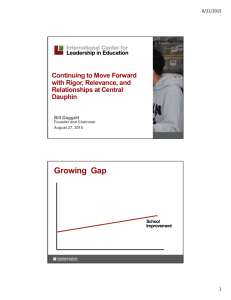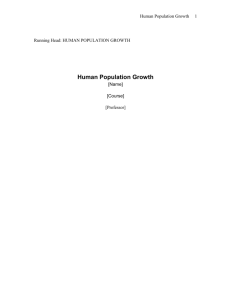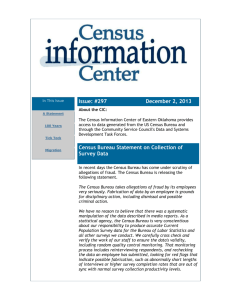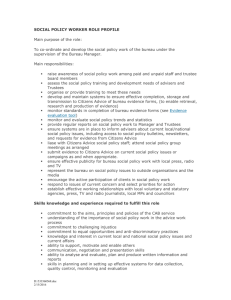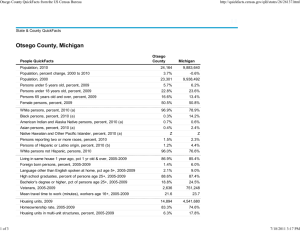Growing Gap - International Center for Leadership in Education
advertisement
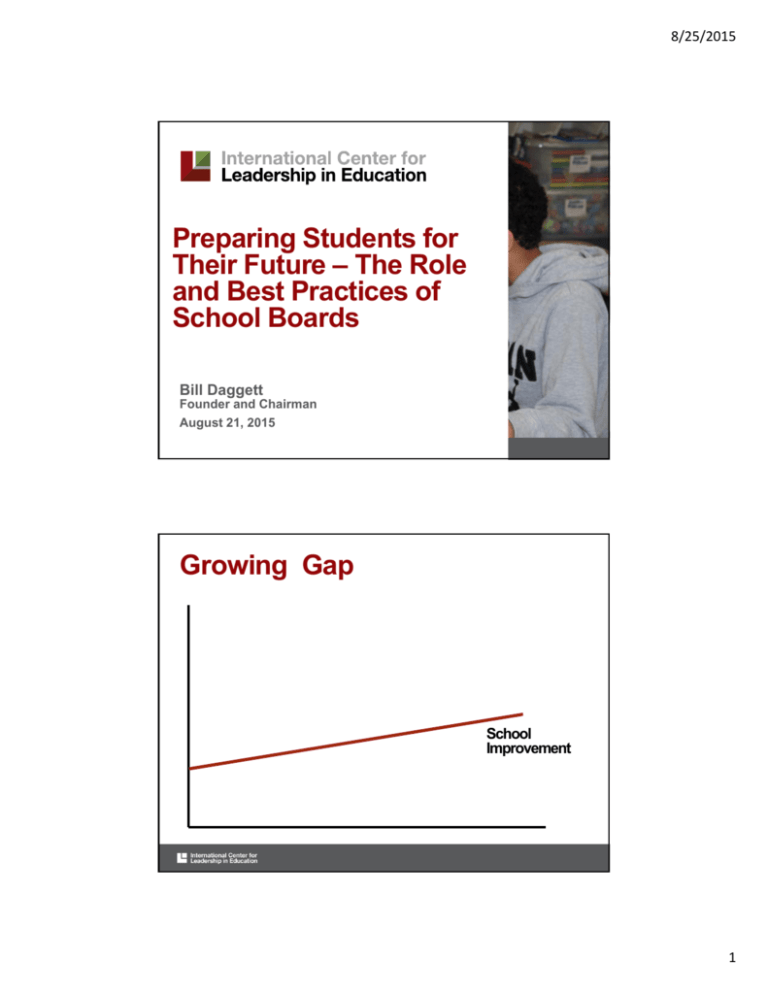
8/25/2015 Preparing Students for Their Future – The Role and Best Practices of School Boards Bill Daggett Founder and Chairman August 21, 2015 Growing Gap School Improvement 1 8/25/2015 Growing Gap School Improvement Reading Study Summary Interquartile Ranges Shown (25% - 75%) Text Lexile Measure (L) 1600 1400 1200 1000 800 600 High School Literature College Literature High School Textbooks College Textbooks Military Personal Use Entry-Level Occupations SAT 1, ACT, AP* Source: National Test Data, MetaMetrics 2 8/25/2015 Grade 4 Reading Proficiency MA 234 TN 170 Grade 8 Reading Proficiency MO 267 TX 201 3 8/25/2015 Grade 4 Math Proficiency MA 255 TN 195 Grade 8 Math Proficiency MA 300 TN 229 4 8/25/2015 Growing Gap School Improvement Growing Gap School Improvement 5 8/25/2015 Growing Gap School Improvement Systemwide Focus 6 8/25/2015 7 8/25/2015 8 8/25/2015 Organizational Leadership 9 8/25/2015 Culture Trumps Strategy (Do you have a plan?) Two Approaches to School Improvement Fixed Mindset (Quad A/C) 10 8/25/2015 Two Approaches to School Improvement Fixed Mindset Growth Mindset Begin with an Instructional Framework 11 8/25/2015 Application Model 1. Knowledge in one discipline 2. Application within discipline 3. Application across disciplines 4. Application to real‐world predictable situations 5. Application to real‐world unpredictable situations Knowledge Taxonomy 1. Remembering 2. Understanding 6. 3. Applying 5. 4. Analyzing 5. Evaluating 4. 6. Creating 1. 2. 3. 12 8/25/2015 Levels 6 5 4 3 2 1 Rigor 1 C D A B 2 3 4 5 Relevance Rigor / Relevance Framework 6 5 4 3 2 1 1 2 3 4 5 • • • • • • • • Analyze the graphs of the perimeters and areas of squares having differentlength sides. Determine the number of solutions for three different equations. Identify coordinates for ordered pairs that satisfy an algebraic relation or function. Determine and justify the similarity or congruence for two geometric shapes. Represent fractions on a number line. Classify triangles according to angle size and/or length of sides. Calculate volume of simple threedimensional shapes. Given the coordinates of a quadrilateral, plot the quadrilateral on a grid. • • • • • • • • Obtain historical data about local weather to predict the chance of snow, rain, or sun during year. Test consumer products and illustrate the data graphically. Plan a large school event and calculate resources (food, decorations, etc.) you need to organize and hold this event. Design a new currency and trading rules for an online game. Draw a timeline of your life accomplishments. Calculate the incline of a new handicap ramp to be installed at the front entrance of the school. Determine the median and mode of weather data from the past week. Organize and display collected data, using appropriate tables, charts, or graphs. 13 8/25/2015 Rigor / Relevance Framework 6 • Represent fractions on a number line. 5 • Classify triangles according to angle and/or length of sides. 4 • size Calculate volume of simple threeshapes. 3 • dimensional Given the coordinates of a quadrilateral, plot the quadrilateral on 2 a grid. 1 1 2 3 4 5 Rigor / Relevance Framework 6 • Draw a timeline of your life 5 accomplishments. • Calculate the incline of a new handicap 4 ramp to be installed at the front entrance of the school. • Determine the median and mode of 3 weather data from the past week. and display collected data, using 2 • Organize appropriate tables, charts, or graphs. 1 1 2 3 4 5 14 8/25/2015 Levels 6 5 4 3 2 1 1 C D A B 2 3 4 5 Relevance College Ready (College Prep) Rigor Rigor C D A B Relevance 15 8/25/2015 Rigor Job Ready (CTE) C D A B Relevance Rigor Career Ready C D A B Relevance 16 8/25/2015 Levels 6 5 4 3 2 1 Rigor 1 C D A B 2 3 4 5 Relevance Two Approaches to School Improvement Fixed Mindset (Quad A/C) C D A B C D A B Growth Mindset (Quad B/D) 17 8/25/2015 WHY WHAT WHY WHAT HOW HOW 18 8/25/2015 Fundamental Shift Those Schools that pull students out of Art, Music, Physical Education, and CTE for remediation have a fixed (A/C) mindset Source: Better and Faster, Jeremy Gutsche Fundamental Shift Schools that drive academics into Art, Music, Physical Education, and CTE – as well as – drive Art, Music, Physical Education and CTE into academics have a growth (B/D) mindset Source: Better and Faster, Jeremy Gutsche 19 8/25/2015 Practices • Looping • Department Chairs • Professional Learning Communities • Reading • Writing Intensive • Iphone • 1/3 Practices • Constant Search for Innovative Best Practices • Redefined Community 20 8/25/2015 Changing Neighborhoods Source: The Vanishing Neighbor Networked Communities Social media is creating a new sense of ‘community’ tied together by common interests and not physical proximity to each other 21 8/25/2015 Ideological Monolithic Communities Fixed Mindset schools have doubled down on the past 22 8/25/2015 Fixed Mindset schools have doubled down on the past Technology is transforming Growth Mindset Schools Gamification 23 8/25/2015 Gaming is increasingly being built based upon brain research Gamification Engaging 24 8/25/2015 Gamification Engaging Personalized Gamification Engaging Personalized Built on Growth Model 25 8/25/2015 Gaming • Work hard and can postpone immediate pleasures • Not derailed by difficulties • Seek out challenges • Remain engaged over long haul Gamification Engaging Personalized Built on Growth Model Tied to Standards 26 8/25/2015 Gamification Engaging Personalized Built on Growth Model Tied to Standards Merging with Online Providers The Military and the Corporate world are increasingly moving to game technology for training 27 8/25/2015 Districts Need a Gamification, Online, and Digital Literacy Policy and Plan Stride Academy 28 8/25/2015 Stride Academy/USNH Culture Trumps Strategy 29 8/25/2015 The Latest Solution Becomes the Newest Enemy Do your schools need an initiative/program OR a Lifestyle Change 30 8/25/2015 Larger Context I Am Increasingly Worried 31 8/25/2015 Percentage of Teachers Satisfied with Teaching 2008 2014 65% 38% Source : Fullan, M. and Langworthy, M. New Pedagogies for Deep Learning Larger Context 32 8/25/2015 $ Household Income Where do you fall? Household Income $ $12,000 10% 20% 30% 40% 50% 60% 70% Source: 80% 90% 100% New York Times Analysis of University of Minnesota Population Center Data 33 8/25/2015 Household Income $12,000 10% $ $25,000 20% 30% 40% 50% 60% 70% 80% 90% 100% 25% Source: New York Times Analysis of University of Minnesota Population Center Data Household Income $12,000 10% $51,000 $25,000 20% 30% 25% $ 40% 50% 60% 70% 80% 90% 100% 50% Source: New York Times Analysis of University of Minnesota Population Center Data 34 8/25/2015 Household Income $12,000 10% $51,000 $25,000 20% 30% 40% 25% $ $90,000 50% 60% 70% 50% 80% 90% 100% 75% Source: New York Times Analysis of University of Minnesota Population Center Data Household Income $140,000 $188,000 $ $12,000 10% $51,000 $25,000 20% 30% 25% 40% $90,000 50% 60% 70% 50% 80% 75% Source: 90% 100% 90% New York Times Analysis of University of Minnesota Population Center Data 35 8/25/2015 Household Income $188,000 $140,000 $12,000 10% $51,000 $25,000 20% 30% 25% 40% $400,000 $ $90,000 50% 60% 70% 50% 80% 75% 90% 100% 90% 95% Source: New York Times Analysis of University of Minnesota Population Center Data Retirement Savings Less than $10,000 50% White households Sources: Time, May 18, 2015 National Institute on Retirement Security 36 8/25/2015 Retirement Savings Less than $10,000 50% White households 75% Black households Sources: Time, May 18, 2015 National Institute on Retirement Security Retirement Savings Less than $10,000 50% White households 75% 80% Hispanic households Black households Sources: Time, May 18, 2015 National Institute on Retirement Security 37 8/25/2015 Support Ratio Sources: U.S. Census Bureau, New QuickFacts, Jan 7, 2011 U.S. Bureau of Labor Statistics Under 18 23.3% 74.2M Support Ratio Sources: U.S. Census Bureau, New QuickFacts, Jan 7, 2011 U.S. Bureau of Labor Statistics 38 8/25/2015 Under 18 23.3% 74.2M Support 14.1% Ratio 45M Over 65 Sources: U.S. Census Bureau, New QuickFacts, Jan 7, 2011 U.S. Bureau of Labor Statistics From Pyramid to Rectangle Male Population Age Female 85+ 80 ‐ 84 75 ‐ 79 70 ‐ 74 65 ‐ 69 60 ‐ 64 55 ‐ 59 50 ‐ 54 45 ‐ 49 40 ‐ 44 35 ‐ 39 30 ‐ 34 25 ‐ 29 20 ‐ 24 15 ‐ 19 10 ‐ 14 5 ‐ 9 0 ‐ 4 6 5 4 3 2 Percentage of total population 1 0 0 1960 1 2 3 4 5 6 Percentage of total population Baby Boom Source: https://www.census.gov/population/international/files/97agewc.pdf 39 8/25/2015 From Pyramid to Rectangle Male Population Age Female 85+ 80 ‐ 84 75 ‐ 79 70 ‐ 74 65 ‐ 69 60 ‐ 64 55 ‐ 59 50 ‐ 54 45 ‐ 49 40 ‐ 44 35 ‐ 39 30 ‐ 34 25 ‐ 29 20 ‐ 24 15 ‐ 19 10 ‐ 14 5 ‐ 9 0 ‐ 4 6 5 4 3 2 1 0 0 1 1990 Percentage of total population 2 3 4 5 6 Percentage of total population Baby Boom Source: https://www.census.gov/population/international/files/97agewc.pdf From Pyramid to Rectangle Male Population Age Female 85+ 80 ‐ 84 75 ‐ 79 70 ‐ 74 65 ‐ 69 60 ‐ 64 55 ‐ 59 50 ‐ 54 45 ‐ 49 40 ‐ 44 35 ‐ 39 30 ‐ 34 25 ‐ 29 20 ‐ 24 15 ‐ 19 10 ‐ 14 5 ‐ 9 0 ‐ 4 6 5 4 3 2 Percentage of total population 1 0 0 2020 1 2 3 4 5 6 Percentage of total population Baby Boom Source: https://www.census.gov/population/international/files/97agewc.pdf 40 8/25/2015 Under 18 23.3% 74.2M Support 14.1% Ratio 45M Over 65 Sources: U.S. Census Bureau, New QuickFacts, Jan 7, 2011 U.S. Bureau of Labor Statistics 45 Million and Growing To 80 Million in 2030 41 8/25/2015 18 – 65 Year Olds Not in Full Time Employment 127 Million and Growing 42 8/25/2015 Under 18 23.3% 74.2 M Support 14.1% Ratio 45 M 39.7% 18 ‐ 65 Over 65 127 M • Not employed full‐time • More than half receive government assistance Sources: U.S. Census Bureau, New QuickFacts, Jan 7, 2011 U.S. Bureau of Labor Statistics Under 18 23.3% 74.2 M Subtotal 246.2 M 77.1% Support 14.1% Ratio 45 M 39.7% 18 ‐ 65 Over 65 127 M • Not employed full‐time • More than half receive government assistance Sources: U.S. Census Bureau, New QuickFacts, Jan 7, 2011 U.S. Bureau of Labor Statistics 43 8/25/2015 Under 18 Public Employment 23.3% 74.2 M 7% 22.4 M Subtotal 246.2 M 77.1% Support 14.1% Ratio 45 M 39.7% Over 65 127 M 18 ‐ 65 Not in FT Employment and over half of whom receive Government assistance Sources: U.S. Census Bureau, New QuickFacts, Jan 7, 2011 U.S. Bureau of Labor Statistics Total 268.6 M 84.1% Under 18 Public Employment 23.3% 74.2 M 7% Subtotal 246.2 M 77.1% 22.4 M Support 14.1% Ratio 45 M 39.7% 18 ‐ 65 Over 65 127 M Not in FT Employment and over half of whom receive Government assistance Sources: U.S. Census Bureau, New QuickFacts, Jan. 7, 2011 U.S. Bureau of Labor Statistics 44 8/25/2015 Total 303.6 M 91% Public Employment Under 18 23.3% 7% 74.2 M 22.4 M Subtotal 281.2 M 84% Support Ratio 39.7% 18 ‐ 65 21% 80M Over 65 127 M Not in FT Employment and over half of whom receive Government assistance Sources: U.S. Census Bureau, New QuickFacts, Jan. 7, 2011 U.S. Bureau of Labor Statistics Sources: U.S. National Debt Clock http://www.brillig.com/debt_clock 45 8/25/2015 National Debt from 1940 to Present Sources: U.S. National Debt Clock http://www.brillig.com/debt_clock U.S. Obligations • National Debt ‐ $18.3 Trillion • Obligations via Social Security, Medicare, Medicaid ‐$205 Trillion • 12 times Nation’s GDP 46 8/25/2015 Underfunded State Pension Funds • $5 Trillion 127 Million and Growing They need to go to work!!! 47 8/25/2015 They are both our responsibility and our solution 48 8/25/2015 49
